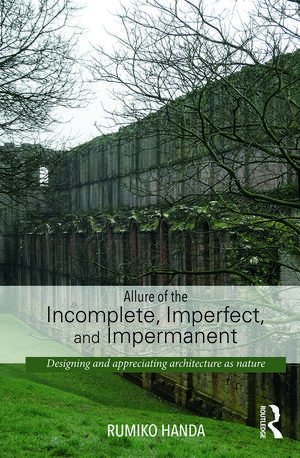Allure of the Incomplete, Imperfect, and Impermanent: Designing and Appreciating Architecture as Nature
Autor Rumiko Handaen Limba Engleză Hardback – 15 ian 2015
Rumiko Handa argues it is time to correct this imbalance. Using examples ranging from the Roman Coliseum to Japanese tea rooms, she draws attention to an area that is usually ignored: the allure of incomplete, imperfect and impermanent architecture. By focusing on what happens to buildings after they are ‘complete’, she shows that the ‘afterlife’ is in fact the very ‘life’ of a building.
However, the book goes beyond theoretical debate. Addressing professionals as well as architecture students and educators, it persuades architects of the necessity to anticipate possible future changes and to incorporate these into their original designs.
| Toate formatele și edițiile | Preț | Express |
|---|---|---|
| Paperback (1) | 423.09 lei 6-8 săpt. | |
| Taylor & Francis – 15 ian 2015 | 423.09 lei 6-8 săpt. | |
| Hardback (1) | 1327.80 lei 6-8 săpt. | |
| Taylor & Francis – 15 ian 2015 | 1327.80 lei 6-8 săpt. |
Preț: 1327.80 lei
Preț vechi: 1619.27 lei
-18% Nou
Puncte Express: 1992
Preț estimativ în valută:
254.08€ • 271.69$ • 211.84£
254.08€ • 271.69$ • 211.84£
Carte tipărită la comandă
Livrare economică 17 aprilie-01 mai
Preluare comenzi: 021 569.72.76
Specificații
ISBN-13: 9780415741507
ISBN-10: 0415741505
Pagini: 238
Ilustrații: 61
Dimensiuni: 156 x 234 x 18 mm
Greutate: 0.48 kg
Ediția:1
Editura: Taylor & Francis
Colecția Routledge
Locul publicării:Oxford, United Kingdom
ISBN-10: 0415741505
Pagini: 238
Ilustrații: 61
Dimensiuni: 156 x 234 x 18 mm
Greutate: 0.48 kg
Ediția:1
Editura: Taylor & Francis
Colecția Routledge
Locul publicării:Oxford, United Kingdom
Public țintă
General, Postgraduate, Professional, and UndergraduateCuprins
Introduction Part 1: Problematic Notion of Complete, Perfect, and Permanent Architecture 1. Mutability of Architecture 2. Authorial Authority 3. Alienation from the Everyday Part 2: Allure of the Incomplete, Imperfect, and Impermanent 4. The Incomplete – Synecdoche 5. The Impermanent – Palimpsest 6. The Imperfect – Wabi Part 3: Articulating the Properties of Engagement 7. Appreciating Architecture as Nature 8. Representing Incomplete, Imperfect, and Impermanent Architecture Conclusion Bibliography Index
Notă biografică
Rumiko Handa is Professor of Architecture at the University of Nebraska-Lincoln, USA. She holds a Ph.D. in Architectural Theory from the University of Pennsylvania and a B.Arch. from the University of Tokyo. Her writings have appeared in: Interiors: Design, Architecture, Culture; The Journal of the Society of Architectural Historians; Preservation Education & Research; The Papers of the Bibliographical Society of America; Design Studies, etc. She co-edited Conjuring the Real: The Role of Architecture in Eighteenth- and Nineteenth-Century Fiction.
Recenzii
‘Readers of this book will be introduced to a rather rare sort of intellectual honesty together with an author’s concern for the concrete reality of architectural works. Rumiko Handa exposes and then overcomes the current tendency to view the building that exists in fact as equivalent to the one that exists in the mind: all-of-a-piece, flawless, and lasting. Examples from both Western and Asian architecture are adduced to provide persuasive revisions of concepts of authorship, longevity, and the building’s participation in the natural world. Offering a new sense of architecture’s endings, this book allows us to imagine new beginnings.’ - David Leatherbarrow, University of Pennsylvania
Descriere
Buildings continue changing once ‘complete’. Examining the allure of incomplete, imperfect and impermanent architecture, professionals, students and educators are called upon to anticipate future changes by incorporating them into their designs.





